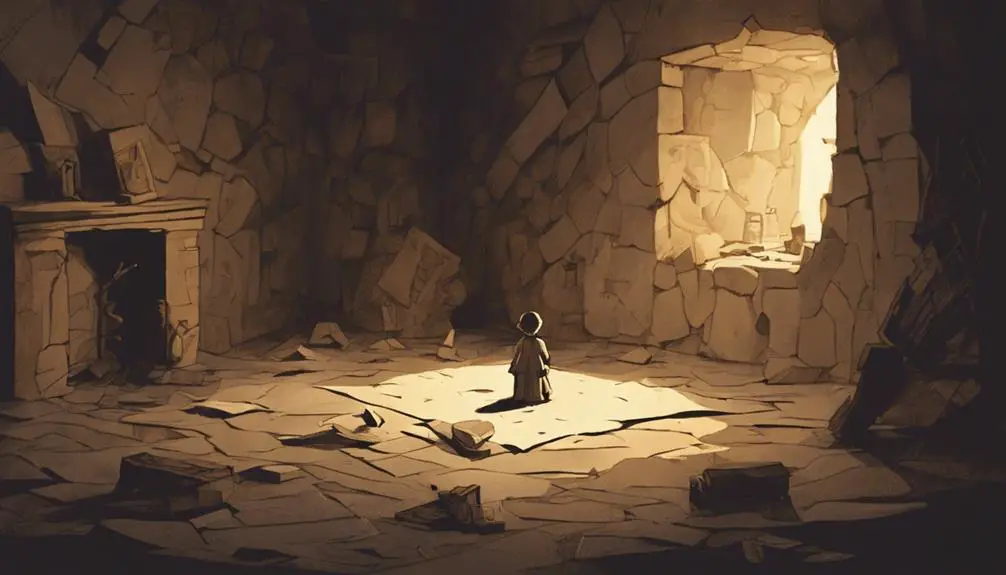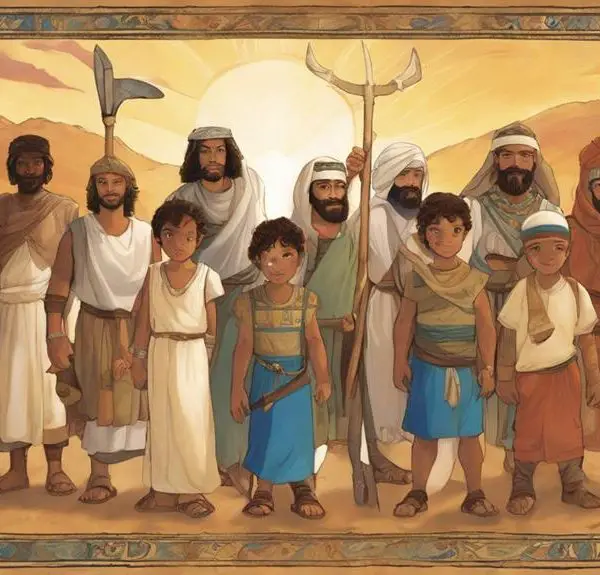Learn how childhood traumas depicted in the Bible reflect on resilience and survival, sparking a profound conversation on their impacts.

Childhood Trauma in the Bible
As they say, what doesn't kill you makes you stronger, but when you look into the Bible, the stories of childhood trauma might leave you questioning the long-term effects on those involved. Consider Isaac's near sacrifice, Joseph's enslavement, Moses adrift in the Nile, David's early hardships, and the Massacre of the Innocents.
These narratives not only highlight the resilience of the human spirit but also open a window into understanding trauma's impact through a biblical lens. Stick around to uncover how these ancient texts might influence our comprehension of trauma and resilience today, without even turning a page.
Key Takeaways
- Biblical narratives often depict childhood trauma through abandonment, betrayal, and familial deception, impacting the characters' development and relationships.
- Early experiences of trauma, such as Isaac's near-sacrifice and Joseph's enslavement, lead to deep psychological scars and trust issues within families.
- The stories of Moses and David demonstrate how abandonment and early hardships can shape future leaders, despite their traumatic beginnings.
- Sibling rivalry and betrayal, as seen in Joseph's story, highlight the emotional and identity struggles resulting from familial conflicts.
Isaac's Near Sacrifice

The near sacrifice of Isaac, a pivotal event in the Hebrew Bible, serves as a profound example of childhood trauma within a religious narrative. This story, often referred to as the Akedah, showcases a crucial moment where parental trust is severely tested, if not outright shattered. As you delve into this narrative, it's essential to consider the psychological impact on Isaac, who wasn't only a son but also an unwitting participant in a divine test of faith.
You're compelled to analyze the dynamics at play, especially the erosion of trust between Isaac and his father, Abraham. This incident likely left deep psychological scars, affecting Isaac's perception of safety and security. The Akedah story vividly illustrates how extreme religious obedience can inadvertently inflict trauma on the younger generation.
Moreover, the narrative opens a window into understanding the complex layers of parental trust and its implications for a child's psychological development. The trauma Isaac experienced underscores the delicate balance between faith and the welfare of one's child. As you reflect on this story, it becomes clear that the psychological impact of such an event can resonate throughout a person's life, influencing their relationships and worldview.
Joseph's Enslavement
Reflecting on Isaac's ordeal, we now turn our attention to another profound biblical narrative of childhood trauma: Joseph's enslavement by his own brothers. This story, steeped in sibling rivalry and dream interpretation, offers a rich tapestry for understanding early traumas. Joseph, favored by his father, becomes the target of his brothers' envy, culminating in their plot to sell him into slavery.
Aspect |
Impact on Joseph |
|---|---|
Sibling Rivalry |
Alienation & Betrayal |
Dream Interpretation |
Misunderstood & Isolated |
Enslavement |
Loss of Freedom & Identity |
Familial Deception |
Trust Issues & Emotional Scars |
Joseph's dreams, initially a source of pride, turn into a catalyst for his downfall, highlighting the dangers of misunderstood gifts. The act of enslavement by his siblings not only strips Joseph of his freedom but also forces him into an identity crisis, far from the safety of his father's house. This narrative underscores the complexity of familial relationships and the deep psychological scars that can result from betrayal and misunderstanding within a family. Joseph's story, rich in themes of redemption and resilience, begins with a profound childhood trauma that shapes his journey and destiny.
Moses in the Nile

In a narrative marked by desperation and hope, Moses' mother places him in the Nile, a decision driven by the perilous decree against Hebrew boys. This act, while fraught with danger, is also a testament to a mother's love and her hope for her child's survival. It's a pivotal moment that underscores the themes of Nile survival and royal adoption, which are crucial to understanding Moses' journey.
Here are three key points to consider:
- Nile as a Place of Danger and Salvation: The Nile, representing both mortal peril and the providential avenue for Moses' survival, encapsulates the dual nature of his early life's circumstances.
- Royal Adoption as a Means of Preservation: The adoption of Moses by Pharaoh's daughter not only secures his survival but also places him in a position of influence within the very system that sought his demise.
- Psychological Impact of Moses' Early Experiences: These early experiences of abandonment and adoption likely shaped Moses' identity, his sense of belonging, and his eventual leadership style.
This analysis reveals how Moses' formative experiences of Nile survival and royal adoption are central to understanding his complex character and his pivotal role in Biblical narratives.
David's Early Hardships
Just as Moses faced trials from his earliest moments, David's upbringing was also marked by significant hardships that shaped his path and character. You'll find that David's early life, before his famous Goliath confrontation, was characterized by the solitude and dangers of shepherd life, a profession that demanded constant vigilance and strength.
Aspect |
Description |
Impact on David |
|---|---|---|
Family Position |
Youngest son, often overlooked |
Developed resilience |
Shepherd Life |
Constant threat from predators |
Fostered courage |
Anointing |
Secretly anointed king, creating tension |
Instilled purpose |
Goliath Challenge |
Faced Goliath when others hesitated |
Proved his leadership |
This table captures the essence of David's early struggles and how each experience contributed to his development. His position in his family meant he had to fight harder for recognition, teaching him resilience. As a shepherd, he encountered lions and bears, honing his courage. The secret anointing by Samuel placed a heavy burden of expectation on his shoulders, molding his sense of destiny. Finally, the confrontation with Goliath solidified his role as a leader in the eyes of his people. Analyzing these elements, you grasp how David's early hardships were not just obstacles but stepping stones to his future greatness.
Massacre of the Innocents

Analyzing the Massacre of the Innocents reveals a harrowing episode of biblical violence that profoundly impacted the early Christian narrative. This event, rooted in Herod's fear of losing his throne to a newborn 'King of the Jews,' led to the tragic order to kill all male infants in Bethlehem. This act of brutality not only exemplifies the lengths to which power can corrupt but also sets a somber backdrop for the emergence of Jesus's ministry.
Consider these aspects:
- Herod's Fear: Driven by paranoia and the desire to maintain control, Herod's decision to massacre innocent children underscores the historical context of political power struggles and their devastating effects on the most vulnerable.
- Religious Interpretation: This event has been interpreted in various ways, often seen as a fulfillment of prophecy and a prefiguration of Jesus's own fate. It reflects on themes of innocence, martyrdom, and the clash between worldly and divine powers.
- Impact on Christian Narrative: The Massacre of the Innocents deepens the narrative of Jesus's early life, adding a layer of tragedy that highlights the profound cost of salvation and the pervasive presence of evil in the world.
Frequently Asked Questions
How Do Modern Psychological Theories Interpret the Long-Term Effects of Witnessing or Experiencing Such Traumatic Events as Depicted in Biblical Stories on Children's Mental Health?
Modern psychological theories suggest that witnessing or experiencing traumatic events can have a profound neurological impact on children. These theories delve into how trauma affects brain development, potentially leading to long-term mental health issues.
However, they also emphasize the importance of resilience building. Through therapeutic interventions and supportive environments, children can develop the resilience needed to overcome these adversities, highlighting a pathway to healing and psychological well-being.
Are There Any Biblical Figures Who Showed Signs of What We Would Now Recognize as PTSD (Post-Traumatic Stress Disorder) Due to Their Childhood Experiences, Outside of the Stories Mentioned?
Exploring figures with potential PTSD, you'll find Moses' exile and Joseph's enslavement as key examples. Interestingly, about 70% of adults experience at least one traumatic event in their lifetime, suggesting these biblical characters' experiences resonate deeply with many.
Moses' isolation and leadership burdens, alongside Joseph's betrayal and imprisonment, reflect symptoms of PTSD in a historical context, showcasing their profound psychological impacts without directly mentioning childhood trauma in the Bible.
How Have Different Cultures and Religions Historically Interpreted and Taught These Stories of Childhood Trauma in the Bible to Children Without Causing Fear or Trauma?
You're exploring how cultural storytelling and religious pedagogy have historically navigated sharing potentially traumatic biblical narratives with children.
Various cultures and faith communities have developed nuanced methods to interpret and teach these stories, often focusing on moral lessons or resilience rather than the trauma itself.
This approach ensures that the core values and teachings are imparted without instilling fear, highlighting the adaptability and sensitivity inherent in religious education across different societies.
What Coping Mechanisms or Support Systems, if Any, Does the Bible Suggest for Children Who Have Gone Through Traumatic Experiences?
You're navigating a digital age dilemma, seeking ancient wisdom for modern problems. The Bible, while not a self-help manual, subtly suggests healing prayers and community support as vital for overcoming traumatic experiences. It advocates for a communal embrace, where shared stories and prayers serve as the balm for wounded spirits.
This approach, both analytical and contextual, underscores the timeless nature of healing—highlighting that, even millennia ago, connection and spirituality were seen as crucial for recovery.
How Do These Biblical Narratives of Childhood Trauma Compare to Childhood Trauma Narratives in Other Major Religious Texts, and What Can We Learn From These Comparisons?
When you explore comparative mythology, you'll find that narratives of childhood trauma in religious texts offer unique insights. These stories, across different faiths, provide a rich tapestry for understanding healing rituals and coping mechanisms.
Conclusion
As you've journeyed through these biblical narratives, it's clear that childhood trauma isn't a modern phenomenon. From Isaac's brush with death to Moses's precarious start, these stories reveal profound insights into human resilience and divine providence. They challenge us to reconsider our understanding of trauma and healing within ancient texts.
As the shadows of these ancient traumas linger, they beckon us to delve deeper, seeking wisdom in the scars of the past to illuminate the paths of the future.



Sign up